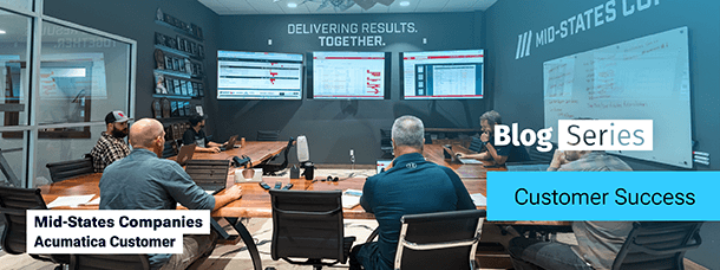In this article:
What is Warehouse Automation?
Top Trends in Warehouse Automation
– Collaborative Robots
– Warehouse Management Systems and Software
– Automated Storage and Retrieval Systems
– Automated Guided Vehicles and Autonomous Mobile Robots
– Radio-frequency Identification
– Cloud-based Operations
– Modular Solutions
– Predictive Maintenance
Implementing Warehouse Automation Platforms and Technologies
What is Warehouse Automation?
Warehouse automation is the use of technology and automated systems to perform repetitive warehouse processes and tasks (physical automation) and to eliminate manual data entry (digital automation). Physical and digital warehouse automation ensure a more efficient, safe, and error-free operation, which increases the bottom line, protects employees, and improves customer satisfaction. Automation is crucial for distributors to capture data quickly and accurately. ERP and WMS technologies expedite data entry using technologies such as barcoding, RFID, and more.
According to G2, online sales of physical goods are expected to reach $563 million by 2024, but the average size of a warehouse is just over 181,000 square feet. With these statistics, it’s not surprising that 87% of surveyed decisionmakers are either expanding or planning to expand their warehouses by 2024. It’s also not surprising that the amount of new warehousing space that will be required by 2035 is estimated to be 2.3 billion square feet.
This is an exciting time for companies with warehouse operations. But, unfortunately, those relying on outdated solutions and human effort alone to fill their warehouse management needs can anticipate only one thing: a short shelf life. Competing in today’s digital marketplace while meeting growing customer demand for fast shipping means investing time, effort, and funds into warehouse automation.
To better understand this, let’s look at the top trends in warehouse management automation.
The Top Trends in Warehouse Automation Technology and Devices
1. Collaborative Robots
Collaborative robots, which are also known as “cobots,” work side-by-side with—and enhance the abilities of—humans. The history of robotic innovations, stretching from industrialized robots to cobots, is covered extensively in an article by Man + Machines. According to author Jean-marc Buchert, the idea of creating a more flexible robot that could manipulate objects began in the early 1990s.
Because they assist with hazardous, difficult, or repetitive tasks, cobots are an invaluable tool for warehousing operations, even more so as their capabilities have advanced. Buchert notes: “Cobots also feature more and more advanced sensing capabilities to sense their surroundings, prevent collisions and increase the safety of humans. The best cobots today are easy to use, so that, in many cases, workers don’t even need an engineering degree to run them. Therefore, they have become a great way for companies to relieve workers from dangerous and difficult tasks. They make their work easier and allow them to do more creative and productive tasks, like quality control and crafting of industrial parts.”
Cobots can integrate easily into a warehouse operation’s existing infrastructure. They’re lightweight, mobile, and easily programmed. They’re also less expensive than industrial robots. Even better, cobots—which can be used in picking, packing, inspecting, and shipping processes or to optimize picking routes—improve the safety and quality of the jobs performed by employees.
2. Warehouse Management Systems and Software
A warehouse management system (WMS) helps companies efficiently manage materials and goods, from the time they enter the warehouse until they depart. A WMS provides real-time inventory tracking, accurate equipment location and coordination, accurate team resourcing, automatic data capture, automated schedules, and hands-free operations. Often, a WMS works in conjunction with an enterprise resource planning (ERP) solution, which acts as the central repository for WMS data.
As eCommerce rapidly grows, so do the size and complexity of warehouse operations. So, it’s in a company’s best interest to use a WMS—a fact many businesses are beginning to recognize. According to MarketsandMarkets, the global warehouse management system market size “is expected to grow from USD 2.8 billion in 2021 to USD 6.1 billion by 2026.”
3. Automated Storage and Retrieval Systems
Automated storage and retrieval systems (AS/RS) are completely automated systems built on tracks and vertical racks. Items stored in the racks are found and retrieved by computer-controlled equipment, such as shuttles, carousels, and vertical lift modules (VLMs). Within this single system, companies can simplify all their warehousing needs, from picking and storage to assembly (and anything in between).
Some sources indicate that AS/RS accuracy levels exceed 99%. Additional benefits include less wasted space, increased labor productivity, and reduced costs. AS/RS technologies can also help monitor conditions in storage units and ensure security.
4. Automated Guided Vehicles and Autonomous Mobile Robots
Using employee resources to move materials is not effective time management. According to Mobile Industrial Robots (MiR), automated guided vehicles (AGVs) and autonomous mobile robots (AMRs) can optimize productivity, effectively schedule deliveries, and give employees time to focus on higher-level activities. MiR also notes that AMRs are beginning to challenge the popularity of AGVs.
AGVs follow fixed routes, have limited on-board intelligence, and operate on simple programming instructions. They cannot navigate around obstacles, so, if they run into any, they stop until the obstacles are removed. AMRs, on the other hand, can find their way around a building using data from cameras, built-in sensors, laser scanners, and software—maneuvering around obstacles and finding the best routes.
Both AGVs and AMRs can help warehousing operations, but the flexibility and affordability of AMRs suggest they may be the right choice for future-minded companies.
5. Radio-frequency Identification
Radio-frequency identification (RFID) tags are attached to or embedded in objects, and they transmit and receive information through an RFID reader and antennas. RFID data, which can synch with the Internet of Things (IoT) and with an ERP solution, allows warehousing operations to track goods, monitor equipment, review transportation conditions, identify operational inefficiencies, and more—all without manual intervention. The result is increased visibility, reduced labor costs, improved accuracy, and enhanced speed.
6. Cloud-based Operations
Cloud computing continues to gain popularity for warehouse processes management. On-premises solutions require investments into hardware, a space to house that hardware, and an IT staff to set up, monitor, secure, and update the system. But cloud-based software is implemented, managed, and secured by the software vendor. It also seamlessly integrates with existing applications without using complex workarounds.
Warehouse management automation goes hand-in-hand with cloud computing, which helps companies streamline workflows, gather data, and automate procedures through a single, centralized solution. Information from such a central repository is accessible anytime, from anywhere—making cloud-based software a flexible, sustainable solution for warehouse operations.
7. Modular Solutions
The trend of flexibility and sustainability continues with modular solutions. Dockzilla’s modular warehouses are a perfect example.
In “Modular Warehouse Transforms Property Into a Plug-and-Play Distribution Center,” Dockzilla discusses the pandemic-induced increase in at-home deliveries and how distribution companies have struggled to set up and secure appropriate warehouse space to fill demand. With Dockzilla’s modular warehouses, companies have “innovative all-in-one ‘pop-up’ structures” that “combine the necessary loading dock equipment needed for expedited order fulfillment and can be delivered and assembled in just a few weeks.”
The article continues: “What’s more, they can be dismantled and shipped elsewhere to be repurposed as needed, making them especially valuable in an ever-evolving marketplace.”
This “plug-and-play” modularity keeps companies agile, helping them pivot in unexpected circumstances. And it’s not just limited to equipment, like Dockzilla’s warehouses. Any technology or device is “plug-and-play” if it works with a system immediately after being connected (“plugged in”) to that system.
8. Predictive Maintenance
The days of reacting to problems or challenges as they arise are numbered. With today’s predictive maintenance software systems, companies can monitor equipment through data sensors and determine when corrective measures are needed to fend off more complex issues and downtime.
A Deloitte Analytics Institute paper notes: “Knowing well ahead of time when an asset will fail avoids unplanned downtimes and broken assets. On average, predictive maintenance increases productivity by 25%, reduces breakdowns by 70%, and lowers maintenance costs by 25%.”
Download Warehouse Automation Solution Brief
Implementing Warehouse Automation Platforms and Technologies
It’s clear that these trends in warehouse management automation can benefit companies with warehouse operations, but, if a company plans to implement any warehouse automation tactic, it must start with two important points.
First, the company must analyze and assess its specific needs and workflows. Management and team members should understand what pain points would be solved by the chosen warehouse automation platform. Automation itself is only beneficial if a company needs it.
Second, the entire team must be on board before a new platform is implemented. The employees will be using the automation, and, without their buy-in, it may be an expensive and unused investment. The same holds true for any implementation—including that of a cloud ERP solution, like Acumatica.
In “How to Get Organizational Buy-In for Your ERP Implementation (and Why It Matters),” Acumatica’s Sean Chatterjee, Vice President of Partner Sales, writes that “organizational buy-in (or the lack thereof) can make or break your ERP implementation. If employees refuse to use the new system or only use it half-heartedly, your company cannot reap the rewards brought by automating your business management processes.”













